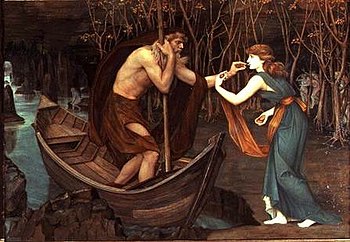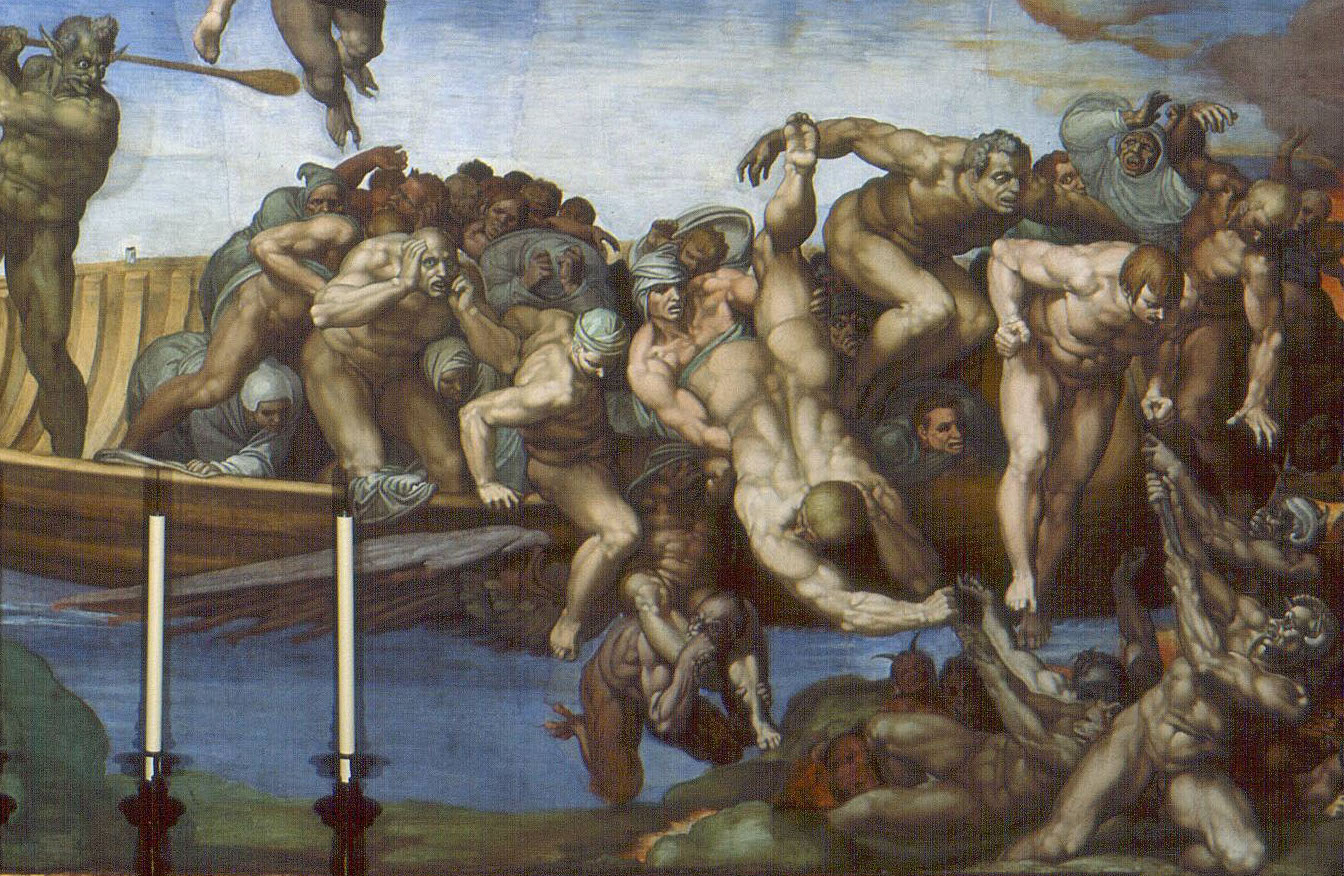Charon, the ancient ferryman of Greek myth, is one of those figures that pops up even where other deities get ignored or forgotten. Sometimes people simply call him ‘the ferryman’ and he loses his name, but we all know who we’re referring to.
But who was Charon, and what is the folklore surrounding him? Hit ‘play’ to hear the podcast episode, or keep reading!
The Common Legend
In simple terms, Charon ferried the dead across the River Styx (or sometimes the Acheron, it varies depending on the source). This journey took them from the land of the living into the underworld.
Such a journey wasn’t free. Charon required payment. People buried their dead with a coin, known as an ‘obol’, in their mouth. In pop culture, it often manifests through characters leaving coins over the eyes of the deceased. In the beautiful Pre-Raphaelite painting below, Charon takes payment from Psyche’s mouth.

If you couldn’t pay the fare, you were doomed to wander the banks of the river forever. Charon would also only take you across once your body was buried, or you’d waited 100 years.
In all honesty, weighting the eyelids with coins probably had more to do with keeping the eyes closed post-mortem. Still, it looks cool in films. Just look at the opening scene of Disney’s A Christmas Carol, when the penny-pinching Scrooge takes back the coins over Marley’s eyelids!
As long as you had the fare, he did let the occasional living being into the Underworld, including; Orpheus, trying to rescue Eurydice; Dionysus, trying to retrieve his mother’s soul; and Dante. I should point out Dionysus was a god. Unlike Orpheus, Dionysus succeeded in bringing Semele back to the world of the living.
If the living wanted to enter the underworld, they needed to present Charon with a golden bough. Aeneas uses it to enter the underworld to visit his father. Naturally, the living needed to hang onto the bough so they could make the trip back across the Styx.
Charon’s Literary Appearances
Charon first pops up in literature in the 6th book of the Aeneid, described by Virgil. He later appears in Dante’s Inferno, and he also gets a namecheck in Shakespeare’s Troilus and Cressida. In more recent pop culture, he appeared in Clash of the Titans (2010) and The Ferryman (2007), as well as being referenced in From Hell (2001).

According to Francis A. Sullivan, while the ferryman pops up in the literature of the 5th and 6th centuries, he also appears on Etruscan monuments in the 4th century (1950: 11). Still, many believe he’s even older. Diodorus Siculus suggested he was an Egyptian import. I’m not entirely sure how, since the Egyptian journey to the afterlife took a very different route.
Literature portrays Charon as “the busy, impatient ferryman, anxious to get the shades aboard and be off to the other side” (Sullivan 1950: 12). In some tales, he chivvies the dead onto his boat, and in the Doré illustration, he even beats them.
The Ferryman’s Changing Appearance
Like many mythological beings, his appearance changes over time. For Seneca, he was an old, haggard man armed with a long pole for guiding his boat. Dante gave him fiery eyes.
Michelangelo included him in The Last Judgment in the Sistine Chapel, by which point he’d become a violent creature prone to beat anyone trying to hold up his boat.

Nowadays, he’s more often a living skeleton in a cowl. He’s nearly always considered to be ancient, and his true nature is difficult to pin down. Charon is not a god, nor is he one of the other immortal beings. He almost seems to exist in a class of his own.
Charon is also interesting in that the concept of ‘paying the ferryman’ existed long after worship of the gods ceased. Cristina Vidal Lorenzo notes the custom of leaving a coin as Charon’s payment even appears in 11th-century literature (2008: 422). There is a possibility that the practise continued, albeit reworked for the Christian church. Here, the coins gained Christian symbols, perhaps to protect against the devil. After all, you wouldn’t need to pay for passage to the underworld if you believed you were going to heaven.
Burial Practices in Reality
If you believe the literary tradition, then putting coins into graves was exceedingly popular. How else would the deceased pay Charon? It’s a point made in From Hell when a victim’s corpse is found with coins over her eyes.
According to MH at the Death in Antiquity blog, the obol was a bronze coin worth 1/6 of a drachma (2016). It equates to a day’s wage for most people. So the fee becomes extremely affordable. You would therefore imagine most graves would contain the fare. In actual fact, they don’t.
Panagiotis Tselekas believes the archaeological evidence doesn’t back up that tradition at all – a lot of burials don’t include coins, and in the ones that do, the number of coins varies (1996: 249). Often the coins are silver or even gold – not bronze.

Contradictions
MH at Death in Antiquity goes so far as to suggest that the coins had nothing to do with the Charon myth at all (2016). Lucia Travaini also points out that the coin can only be called Charon’s obol if it’s found in the mouth (2004: 160). Many coins found in graves are more likely to be offerings, or gifts for the dead to use in the next life (Travaini 2004: 16).
A lot of writers point out the contradictions in the practice. After all, what currency do they actually use in the underworld, and does the fee take inflation into account? Does Charon just appreciate the symbolic act of payment, if not the financial exchange?
Keld Grinder-Hanson makes the point that Charon never really attained an ‘official’ place in Greek mythology. But despite not being a deity, his popularity continued, and he often pops up in contemporary literature instead (1991: 208). By 500BC, he’d even become a symbol for death itself.
Charon’s Evolution Towards Death
So while Death pops up with his scythe and takes souls into the great hereafter, Charon merely ferries them across the Styx. He plays the role of a courier, in a way, simply getting them from A to B.
The Greek pantheon did have a god of death – and it wasn’t Hades. Instead, Thanatos might arrive to escort the soul of the dead from their place of death to the jetty by the Styx. If you were a particularly notable person, the god Hermes would act as your escort. Both Thanatos and Hermes take on the role of psychopomp.
Thanatos is not a terrifying figure. Instead, he’s often invoked alongside his brother, Hypnos, the god of sleep.

That said, there had been an association between Charon and Death in the classical period. John Cuthbert Lawson notes that the door through which condemned prisoners were led to their executions was known as the ‘door of Charon’ (2012: 114).
Names Matter
Sullivan notes that in more recent centuries, the name Hades referred to the underworld itself, rather than its ruler. Charon (now Charos) became its ruler, rather than the ferryman. This promotion led to new duties, too.
Instead of taking souls across the Styx, this new Charos ventured forth on a black horse to snatch up the dead (1950: 16). According to Bergen, Beauchamp and Newell, “the young walk before him, the old behind, young babes are carried on his saddle” (1889: 14).
In Etruscan mythology, he was called Charun, and was more commonly portrayed as a hammer-wielding death demon. He survives in modern Greek folklore as Charos, the angel of death.

This alternative view of Charon as the Grim Reaper fuels the film The Ferryman. In it, not paying the ferryman results in him pursuing a nameless creature through the centuries as it hops through bodies hoping to avoid their final meeting. The film is at pains to point out that you can’t cheat the ferryman, so you can’t cheat death!
Whichever version of Charon you prefer, one thing is clear. He’s somehow transcended the limits of Greek mythology, often referred to simply as ‘the ferryman’, to become a pop cultural icon that represents death…without being the Grim Reaper.
Over to you! Which version of Charon do you prefer?
References
Bergen, Fanny D., Beauchamp W. M., and Newell W. W. (1889) ‘Current Superstitions. I. Omens of Death’, The Journal of American Folklore, 2 (4), pp. 12-22.
Cuthbert Lawson, John (2012), Modern Greek Folklore and Ancient Greek Religion: A Study in Survivals, Cambridge: Cambridge University Press.
Grinder-Hanson, Keld (1991), ‘Charon’s Fee in Ancient Greece? – Some remarks on a well-known death ride’ in Tobias Fischer-Hansen (ed.), Recent Danish Research in Classical Archaeology: Tradition and Renewal, Copenhagen: Museum Tusculanum Press, pp.207-218.
Lorenzo, Cristina Vidal (2008), ‘Funerary Traditions and Death Worship in the Church of the Borgia in Gandía: Interpretations from Archaeology’, World Archaeology, 40 (3), pp. 407-426.
MH (2016), ‘Charon’s myth in relation to Classical Athenian funeral practice’, Death in Antiquity, https://deathinantiquity.wordpress.com/2016/05/15/charons-myth-in-relation-to-classical-athenian-funeral-practice/.
Sullivan, Francis A. (1950) ‘Charon, the Ferryman of the Dead’, The Classical Journal, 46 (1), pp. 11-17.
Travaini, Lucia (2004), ‘Saints and Sinners: Coins in Medieval Italian Graves’ The Numismatic Chronicle, 164, pp. 159-181.
Tselekas, Panagiotis (1996), ‘Grave Hoards of Greek Coins from Greece’ in The Numismatic Chronicle, 156, pp. 249-259.
Sign up below to get these weekly posts straight in your inbox!
Nutty about folklore and want more?
Add your email below and get these posts in your inbox every week.
You'll also get my 5-step guide to protecting your home using folklore!








Excellent post…
Interestingly enough, living people who want to visit Hades could do so… and must, of course also pay the ferryman.
In that case, given the fact that they needed two trips, they were charged more, and several sources indicate that visitors to Hades payed with a golden branch to cross the river and then return.
Thanks for sharing, Icy! Best wishes. Aquileana 🙂
Wow, I didn’t know that! You have to wonder, what did he do with the golden branches?
My image of Charon has always been the skeletal Grim Reaper-like figure, with a barge pole in place of a scythe. Doesn’t mean I don’t like the other interpretations better, though.
Larry Niven wrote a modernized “Inferno,” in which Charon was an ill-tempered old man, making more of an effort to cram his passengers on board than to collect any fare.
I love the version of him in Clash of the Titans where he’s actually part of the boat.
Of course, don’t forget the Chris de Burgh song ‘Don’t Pay the Ferryman!’ Some of his stuff is very sentimental and trite, but I really rather like this one. And the story in the song turns the tale on its head slightly – you don’t pay Charon til you get to the other side, the implication being that the Ferryman will do something horrible to you if you pay before you’re safely over the river.
Wow, I didn’t even know about that one…I’ll have to have a listen!